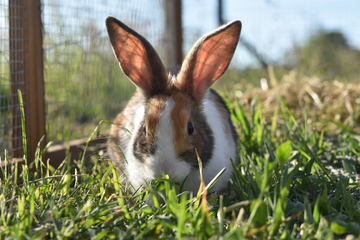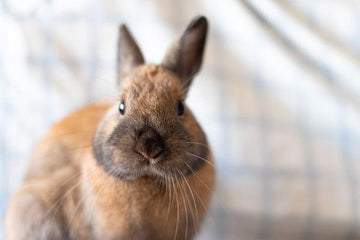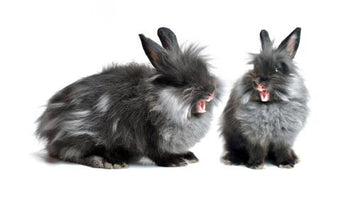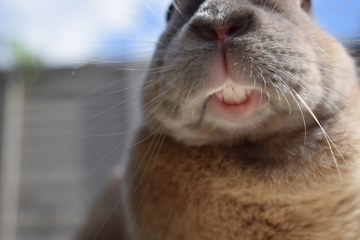What's GI Stasis in Rabbits?
This dangerous condition, known as the silent killer, is brought about by either a delay or complete halt of the rabbit’s normal peristalsis. Peristalsis is the term for the rhythmic muscular contractions needed to move the water and solid food through your bunny’s digestive tract.
Click Here For a Guide to Understanding Your Rabbits Diet.

If you’re feeding your bunny lots of other foods besides hay, then their diet could be mostly high-carb and severely lacking crude fiber. GI prevention is preferable to GI treatment, make sure that you are feeding your rabbit plenty of fresh and green grass hay.
Other causes of GI stasis include:
Dental issues
Urinary tract infections (UTI)
Stress
Gas
Lack of exercise
Dehydration
Intestinal blockages
Other infections
Unless you take your bunny to the vet for a swift diagnosis and treatment plan that is implemented immediately, your beloved pet risks dying a painful and preventable death.
Symptoms and Signs of GI Stasis
Rabbits are near constant feeders, meaning that their digestive tracts are rarely fully empty. With GI stasis, your bun will likely eat up to the point that it literally cannot. You will also note a decrease in bowel movements because the undigested food particles form a semi-solid mass of chewed food and saliva that allows nothing to pass through the GI tract.
Other GI stasis signs to be alert for when providing rabbit care are:
Lethargy
Bloated, tender bellies
Lack of appetite
Loud bowel sounds, i.e., “grumbly tummy”
Bunny balled up in fetal position
Gnashing of teeth (sign of intense pain)
Your rabbit’s stool will also differ in appearance when GI stasis is the culprit. Instead of the dry fecal pellets you are used to cleaning up, with GI stasis, there are few to no pellets. Instead, you might observe tiny pellet particles encased in bile-colored or clear mucus.
How to Treat GI Stasis
In most cases of GI stasis, a veterinarian’s prompt intervention is needed to save your bun’s life. But here is something you can do to try to ease its pain until professional help is available – abdominal massage.
Abdominal massage serves two purposes. The first is that it can ease the rabbit’s pain in the short-term. The second is that it can stimulate the gastric muscles to do their job and reinitiate peristalsis.
To properly perform an abdominal massage, place your bun belly-up on your lap. Speak to it softly while using your fingers and part of your hand to gently massage your bun’s abdomen. You can also increase gas expression by raising its hindquarters while supporting its spine. If your rabbit indicates this positioning or the massage is painful, cease your efforts and make sure you get your rabbit immediately to an emergency vet with knowledge of treating rabbits and other small pets.
How Long Does the Condition Last?
Because of the amount of pain GI stasis can cause your bunny, you don't want it to suffer a moment longer than necessary. The course of the condition can run from several hours to half a week. That's a long time for your bun to suffer! Part of good rabbit care includes being alert to signs and symptoms that something is amiss with your bun.
How Rabbits Recover from GI Stasis
Once you have taken your bunny to the vet, a lot of the treatment your rabbit will get will be supportive of its own natural bodily processes. For example, rehydration is essential to keep a bunny's condition from deteriorating further.
Your vet will likely start an IV infusion of life-sustaining fluids after the initial assessment and physical evaluation. If your pet rabbit has gone a while without eating, it might need to be fed nutritional supplements through a syringe to keep up its strength while it heals.
Antibiotics and motility-enhancing drugs could shorten the duration of the condition, while pain medication and anti-inflammatory medications can bring much-needed relief to your bunny.
Prevention is Key
Some rabbit ailments are unpreventable. Even when practicing good rabbit care, your bun could still suffer from a bout with GI stasis. But to keep your small pet happy and healthy, remember to provide them with lots of fiber in the form of fresh and green grass hay.
Grass hay should be an important staple in the diet of your rabbit, making up 80% of their diet. The constant foraging and grazing encouraged by hay helps to keep them physically active and mentally stimulated. It also helps to wear down their teeth while the long strand fiber helps to keep their digestion regular and functioning properly.

Rabbit Is It Low Maintenance or More Work Than You Think?

Signs of Rabbit Health: What You Should Know

Decoding Bunny Behavior: Understanding Rabbit Mood







